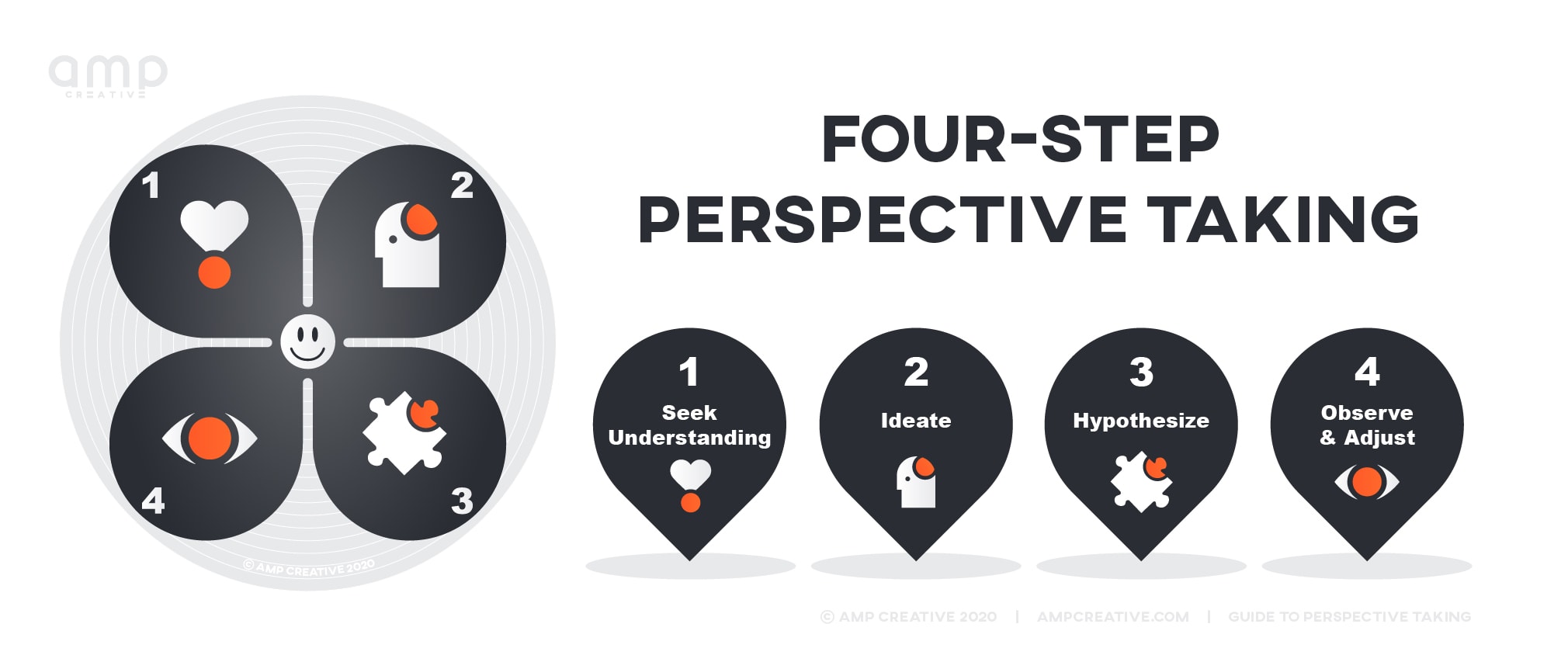What is Perspective Taking?
Perspective taking–“the active contemplation of others’ psychological experiences”(1)–is a powerful tool for conflict resolution, designing human-centered products, and being a better leader. The research shows it has many positive impacts, from increasing team creativity(3) to decreasing implicit bias(2). All it takes is imagining someone else’s worldview. But once you’re ready to try it out, how does perspective taking work? How do you practice and improve your skills once you’ve begun?
We’ll walk you through the basics, from Four-step Perspective Taking to common obstacles. Then we’ll set you up to continue learning in the workplace and beyond.
The Four-step Perspective-Taking Technique
How do you practice perspective taking? Four-step Perpective Taking, created by Amy Lou Abernethy, combines the steps of human-centered design thinking with the act of perspective taking.

1. Seek Understanding
When we are communicating with others, our natural state is to consider our personal goals. In this first step of perspective taking, we mindfully decide to set aside our own goals. Instead, we purposefully center the perspective of the other person. We let go of our egos. We decide, instead, to engage with their lived experience and the way they are perceiving the world.
2. Ideate
How are they perceiving the world? In this step, we imagine several possibilities. We work through the common obstacles to perspective taking (outlined below). Then, we navigate around them to see the other person clearly and imagine how they might be thinking about a situation. These are assumptions – they may not be the truth, but they’re as close as we can get.
We do this until we’re ready to build a hypothesis.
3. Hypothesize
Now that we have some ideas, we narrow our thoughts down to our best guess or guesses. These should be solid hypotheses we can test and use to connect in our interaction with the other person. If our hypothesis is correct, what outcomes would we expect? If we are wrong, how might we know?
4. Observe and Adjust
We hold our hypothesis lightly and are ready for new information about the other person. Now, we are ready to engage with them, observe, and adjust our assumptions. We have an open discussion. We are curious and ready for insights.
Were we able to connect and collaborate with them? If yes, success! If not, it’s time to go deeper and further challenge our assumptions. Whatever the outcome, the process of perspective taking isn’t over. It’s a constant cycle of empathy, imagination, estimation, and discovery.
Obstacles to Taking Another Perspective
Our brains are hardwired to egocentric anchoring and adjustment; in other words, they make us the hero and give others supporting roles. This is why we immediately refer to our own perspective as our base point. Taking another perspective to recognize someone else’s point of view, experience, and beliefs is not a simple feat. It requires hard work and practice. The good news is that, if you put in that effort, it’s a skill anyone can learn.
There are four common obstacles everyone faces when trying to take another’s perspective. These are internal biases. Firstly, we’ll break down each one with examples of ideas rooted in that internal bias. Then, we’ll address ways to notice it–and correct it–in your own thinking.
As you work to move past these obstacles and improve your skills, recognize that these biases are present in everyone. Stop, take a deep breath, and listen. You can get past them.
Fundamental Attribution Error
We blame others when bad things happen to them, but blame external situations when bad things happen to us.
– Teaching Social Perspective Taking (4)
Bias in action
- “I made it this far because I pulled myself up by my bootstraps. If they were more disciplined and put in the work like I did, they wouldn’t need help–so they don’t deserve it.”
- “My A is because I studied hard. My F is because the teacher didn’t explain the material clearly.”
- “I earned this job. They only got here because someone helped them.”
Notice it in yourself
- “Am I asking questions, or am I making assumptions?”
- “Have I taken responsibility for my own actions?”
- “Am I extending the compassion that I would offer myself or my loved ones towards others?”
Acknowledge that luck and the effects of privilege play a huge factor in everyone’s lives. Everyone we know faces circumstances we aren’t aware of. Recognize your mistakes and hold yourself accountable for them; and, if you haven’t, try giving others the benefit of the doubt.
Naïve Realism
We think we see the world as it truly is, and we expect other rational beings to see the world similarly. [When] others’ perceptions differ, perceivers will assume the others are too lazy to [understand], biased, or subject to different (usually inferior) information.
– Teaching Social Perspective Taking (4)
Bias in action
- “They just think that way because they aren’t educated.”
- “Our customers can’t figure this out—what is WRONG with them?!?”
- “They’ve been brainwashed by the media.”
Notice it in yourself
- “Have I considered the fact that I don’t know everything about this situation?”
- “Am I assuming the cause of this behavior or belief instead of listening?”
- “Am I writing people off as lost causes because we don’t agree?”
Consider why you hold your perspective. Ask yourself if the other person had the same experiences as you, or if your different circumstances may have led you to different conclusions. Remember that someone else will perceive a situation differently–witnessing the same events doesn’t mean having the same experience.
Intergroup Bias
We prefer members of our own in-group and have prejudice against out-group members.
– Teaching Social Perspective Taking (4)
Bias in action
- “My country is the greatest in the world.”
- “Don’t do business with (group name)—they don’t pay their bills.”
- “I hired him because he reminds me of myself at that age.”
- “You don’t want to move to that neighborhood.”
Notice it in yourself
- “Have I only put trust in their ideas because they’re like me?”
- “Am I really looking at the facts in this situation, or am I letting pride or fear lead my decision?”
- “Is my thought process being guided by stereotypes?”
- “Am I repeating ideas about other groups without checking them against trustworthy sources?”
Inwardly acknowledge this bias when collaborating with someone outside your “group”—whatever group that might be. Seek input from people who are different from yourself.
Confirmation Bias
We selectively focus on information that confirms our own beliefs.
– Teaching Social Perspective Taking (4)
Bias in action
- “My way or the highway.”
- “I won’t listen—this feels wrong.”
- “I joined an online group recently. There are a lot of people who support and agree with me.”
Notice it in yourself
- “Am I turning away from objective, factual information because it causes me discomfort?”
- “Have I listened to and truly considered opposing arguments?”
- “Am I prioritizing a small group who agree with me over experts who disagree with me?”
Be open to surprise and revelation during collaboration. Learning something new is a positive experience, but it isn’t always easy. Allow yourself to be wrong. Be ready to accept others may have different views that are as valuable as yours.
How to Practice Perspective Taking
There is no way to perfectly take the perspective of another individual. However, the conscious attempt to understand another’s point of view can build new neural pathways, create real learning, and reshape interactions and relationships. That’s why practicing is vital! You can use Four-step Perspective Taking as outlined above for problem-solving at work and in daily life to sharpen your skills. Even better is to practice with others–join your team at the office and continue learning together with some team exercises.
Activities to Practice and Share Perspective Taking with Your Team
These are great for team-building at a retreat or a break at the office. You can apply Four-step Perspective Taking to the situations in these exercises to get the most out of your practice.
Understanding Others: In Character Exercise On Perspective Taking from The Big Book of Conflict Resolution Games – Free
The Message Box by Tanya Tarr for Forbes – Free
Keep Talking and Nobody Explodes from Steel Crate Games – $10
Games and Activities to Work on Perspective Taking – Lego Exercise by Janine Halloran – Free
Bringing Perspective Taking to Your Workplace
This growing field of study offers great promise for the improvement of interpersonal relationships, workplace dynamics, and societies writ large. That’s why we at AMP Creative are pioneering the use of perspective taking in corporate L&D. We’re developing workshops, materials, and exercises so you can bring this skill to your corporate workforce.
Want to bring perspective taking to your organization? We’ll help you create a custom plan. Take your leadership, sales, or diversity and inclusion training to the next level–contact us about a hosting a perspective-taking workshop for your company.
Sources
- Todd, Andrew R., et al. “Perspective taking combats automatic expressions of racial bias.” Journal of personality and social psychology 100.6 (2011): 1027.
- Shih, Margaret, et al. “Perspective taking: Reducing prejudice towards general outgroups and specific individuals.” Group Processes & Intergroup Relations 12.5 (2009): 565-577.
- Hoever, Inga J., et al. “Fostering team creativity: perspective taking as key to unlocking diversity’s potential.” Journal of applied psychology 97.5 (2012): 982.
- Gehlbach, Hunter, Lissa V. Young, and Linda K. Roan. “Teaching social perspective taking: How educators might learn from the Army.” Educational Psychology 32.3 (2012): 295-309.
















